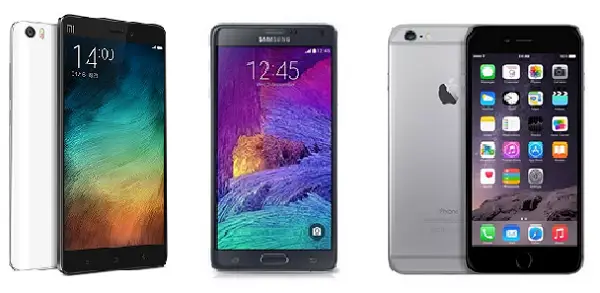Display and Processor
The Mi Note boasts of a 5.7 inch JDI display with Full HD screen resolution of 1920×1080 pixels along with Corning Gorilla Glass 3 protection on top. On the other hand, the Galaxy Note 4 also comes with a similarr 5.7 inch screen, but it is a Super AMOLED panel boasting an increased Quad HD 2560×1440 pixel resolution and Corning Gorilla Glass 4 coating. Lastly, the iPhone 6 Plus comes with a restively smaller 5.5 inch IPS LCD display with Shatterproof Glass for protection against scratches and damages. The handset packs in Retina HD resolution of 1920×1080 pixels onboard. Of all these screens, the Galaxy Note 4 packs in more pixels with 515 pixels per inch and it will definitely be sharper than the rest with lesser pixel count. Also, the Gorilla Glass 4 is two times tougher than the other cover glasses in the market. Notably, the Mi Note features dynamic contrast pixel adjustment responsible for enhancing contrast in darker regions resulting in brighter images. Talking of innards, the Mi Note is powered by a Qualcomm Snapdragon 801 SoC with a quad core processor clocked at 2.5 GHz. The Galaxy Note 4 is launched with a 2.7 GHz quad core Snapdragon 805 processor in India, whereas iPhone is equipped with 64 bit Apple A8 SoC. Though the Apple A8 is twice as powerful as its predecessor, it is known that the Snapdragon 805 is more capable. Also, in terms of RAM, Apple features only 1 GB of RAM, whereas both the Android offerings come with 3 GB of RAM for swifter multitasking and lag free performance.
Camera and Internal Storage
The Mi Note appears not to compromise on the imaging front as well as it boasts of a 13 MP primary snapper that uses a Sony CMOS sensor and two tone flash letting users to adjust the intensity of LED flash. Also, there are other aspects such optical image stabilization, 6p lens and other features. At the front, the device carries a 4 MP selfie snapper with a large 2 micron pixel size to render better self portrait shots even under low ambient light conditions. When it comes to the Galaxy Note 4, the device has a 16 MP primary snapper at its back that sounds better and it is claimed to be an advanced camera with smart optical image stabilization, dual LED flash and auto focus. This uses a Sony IMX240 sensor and there are smart features as well. The front facer onboard the Note 4 is a 3.7 MP one with selfie focused features such as F1.9 aperture to capture 60 percent more light, 90 degree shooting angle and 120 degree wide angle for wider or group selfies. Next is the iPhone 6 Plus with an 8 MP iSight rear camera at its back with FHD 1080p video recording, phase detection auto focus, slow motion video recording, enhanced HDR, optical image stabilization, panorama and True Tone dual LED flash. A 1.2 MP FaceTime HD camera is used at the front of the phone with support for HDR, Burst Mode and F2.2 aperture to capture 80 percent for more light. Storage wise, Xiaomi Mi Note is bundled with 16 GB or 64 GB of native storage space that cannot be expanded further. Also, the iPhone 6 Plus has no provision for additional storage and comes in three variants – 16 GB, 64 GB and 128 GB of default memory capacities. If external storage is your preference for backup or other reasons, the Note 4 with 32 of local storage space should be your choice as it also supports additional storage up to 128 GB with the help of a micro SD card. The handset also comes with 50 GB of free Dropbox cloud storage for two years.
Battery and Features
A 3,000 mAh battery energizes the Mi Note and it should be capable of rendering a decent backup to the smartphone. Furthermore, there is support for Quick Charge 2.0 as well in the Xiaomi smartphone. Galaxy Note 4 has a 3,220 mAh unit that is teamed up with Ultra Power Saving Mode for an extended backup and Adaptive Fast Charging that will charge the Note 4 from zero to 50 percent in 30 minutes. The drawback is that iPhone 6 Plus features a non-removable battery, but it is rated to pump in 24 hours of talk time. On the software front, Xiaomi Mi Note and Samsung Galaxy Note 4 run on Android 4.4 KitKat operating system, but the former is based on MIUI 6 and the latter on TouchWiz UI. The iPhone 6 Plus is way too different as it runs on iOS 8 operating system. The software choice is based on the requirement of the users’ preference. Connectivity wise, all the smartphones come with standard aspects including 4G, but the Galaxy Note 4 features an IR Blaster as well. Also, there is a fingerprint sensor onboard and it comes with a S Pen stylus supporting Air View, Air Gestures, Smart Scroll, S Health and other features making it feature rich.
Key Specs
Conclusion
The Apple iPhone 6 Plus, Xiaomi Mi Note and Samsung Galaxy Note 4 are all high end flagship devices that are competent enough in the market. While the Apple and Samsung offerings are expensive, the Xiaomi phone would be suitable for those who do not want to shell out more on their smartphone purchase. Apart from pricing, the Note 4 seems to be better with an enhanced camera hardware and sharp display. Notably, the availability of the Xiaomi Mi Note would be troublesome as the vendor will opt for flash sales via Flipkart the same way it did with its earlier devices. This would definitely create frustration among potential buyers, hence if Xiaomi plans for retail availability for its phablet it can crush the competition and lure buyers.
